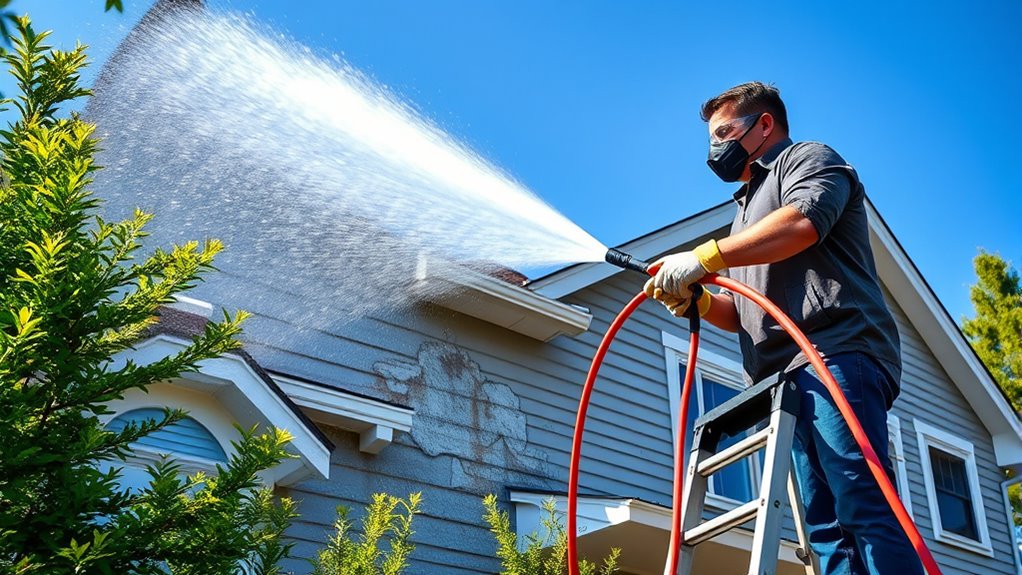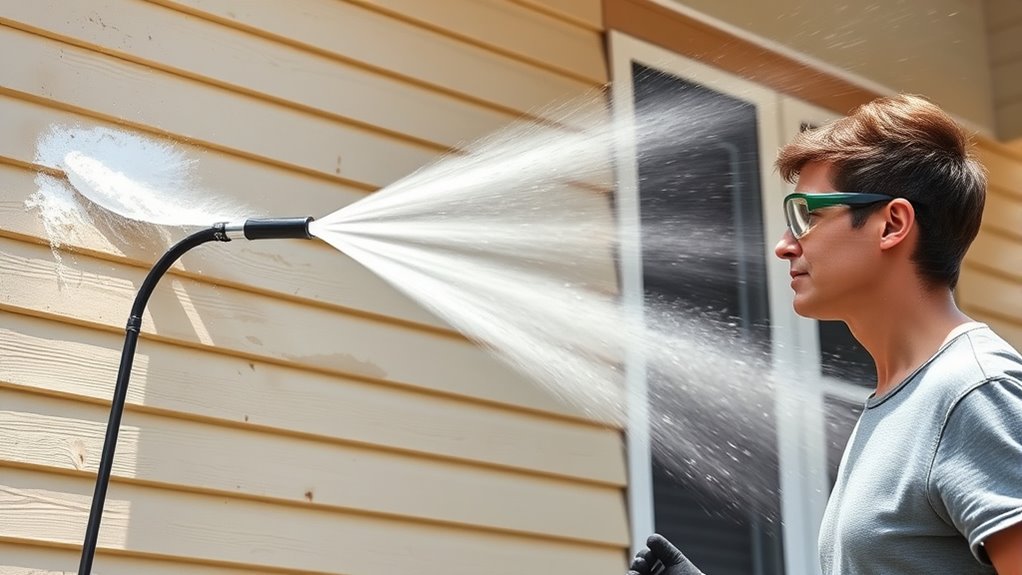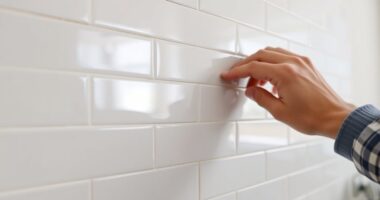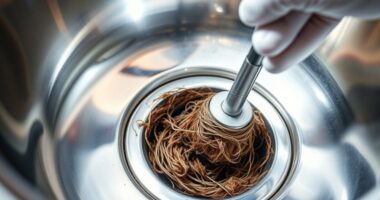To pressure wash your house safely, start by wearing protective gear like goggles, gloves, and non-slip shoes. Keep a safe distance from surfaces, typically about 2 feet, and never point the nozzle at yourself or delicate areas like windows. Use the correct cleaning solutions carefully, following manufacturer instructions, and cover or remove fragile items beforehand. Staying mindful of surroundings and maintaining control of the wand helps prevent accidents—continue with this guide to learn more tips for a safe, effective clean.
Key Takeaways
- Wear safety goggles, gloves, long sleeves, and non-slip footwear to protect yourself from debris, chemicals, and slips.
- Choose and apply the correct cleaning solutions according to manufacturer instructions, avoiding harsh chemicals that can damage surfaces.
- Maintain a safe distance of about 2 feet from the house to prevent surface damage and ensure even cleaning.
- Keep a firm grip on the pressure wand and never point it at yourself, others, or fragile surfaces like windows.
- Cover or remove delicate items and electrical fixtures before starting to prevent damage and safety hazards.

Pressure washing can effectively restore your home’s exterior, but it’s essential to prioritize safety to prevent damage or injury. Before you start, gather the right safety gear to protect yourself during the process. Wear safety goggles to shield your eyes from flying debris and splashes of water or cleaning solutions. A sturdy pair of gloves can protect your hands from harsh chemicals and reduce the risk of cuts or abrasions. Long sleeves and pants are recommended to prevent skin irritation from cleaning solutions and to minimize injury if the pressure washer accidentally contacts your skin. Non-slip footwear is also crucial, as wet surfaces can be slick, increasing the risk of falls. Remember, safety gear isn’t just about comfort; it’s about preventing accidents and health hazards. Incorporating proper safety measures aligns with the importance of data privacy challenges, ensuring your home and surroundings are protected during the cleaning process.
When choosing cleaning solutions, opt for those specifically formulated for pressure washing. Avoid using harsh chemicals that aren’t designed for exterior surfaces, as they can cause damage to your siding, paint, or landscaping. Always read the manufacturer’s instructions carefully, paying attention to the recommended dilution ratios and safety warnings. Many cleaning solutions contain bleach or other strong chemicals, which can be harmful if splashed into your eyes or on your skin. Using protective gear while handling these solutions is vital. Apply the cleaning solutions evenly with a spray nozzle, ensuring you cover all affected areas without oversaturating. Let the solution sit for the recommended time to break down dirt, mold, and grime before rinsing.
Never point the pressure washer nozzle at yourself, others, or delicate surfaces like windows or electrical fixtures. Maintaining a safe distance—usually around 2 feet—helps prevent damage and injury. Keep a firm grip on the pressure wand at all times, especially when starting or stopping, to avoid accidental kicks or sudden surges of water pressure. Be mindful of your surroundings, including plants and outdoor furniture, which can be damaged by high-pressure water or harsh chemicals. Cover or remove sensitive items before beginning to pressure wash.
Frequently Asked Questions
Can I Pressure Wash My House During Rainy or Humid Weather?
You might wonder if you can pressure wash during rainy or humid weather. Weather considerations are important because high humidity and rain can make surfaces slippery and increase the risk of streaks or damage. It’s best to prevent pressure washing in wet conditions to prevent equipment issues and ensure safety. Keep your equipment well-maintained and wait for dry weather to get thorough, effective cleaning without unnecessary risks.
What Should I Do if I Notice Paint Peeling During Pressure Washing?
Imagine paint chips fluttering like autumn leaves as you pressure wash. If you notice peeling paint, stop and assess the damage. Gently rinse the area, then carefully scrape away loose paint to guarantee proper surface prep. This prevents further peeling and creates a clean canvas for repainting, saving you time and money. Addressing peeling early keeps your house looking fresh and helps the new coat adhere better.
How Do I Handle Delicate or Historic Siding Materials?
When handling delicate or historic siding materials, you should use gentle cleaning techniques to prevent damage. Opt for lower pressure settings and a wide spray nozzle, and keep the wand at a consistent distance. Always test a small, hidden area first to guarantee preservation. This approach supports historic preservation while effectively cleaning, so you protect the siding’s integrity without risking harm.
Are There Specific Safety Gear Recommendations for Pressure Washing?
When you’re tackling a cleaning task, safety should be your silent partner. You’ll want protective eyewear to shield your eyes from debris and slip-resistant footwear to prevent falls on wet surfaces. These essentials not only keep you safe but also let you focus on the task at hand. Wearing the right gear guarantees you maintain control and confidence, turning a potentially risky job into a smooth, efficient process.
What Are the Signs of Equipment Malfunction or Damage During Use?
During pressure washing, you should regularly perform equipment inspection to spot damage indicators like leaks, cracks, or loose fittings. If you notice sudden loss of pressure, unusual noises, or spray irregularities, these are signs of equipment malfunction. Address damage indicators immediately by shutting off the machine and inspecting further. Properly maintaining your equipment guarantees safe operation and prevents costly repairs or accidents during your cleaning process.
Conclusion
Remember, pressure washing your house can boost its curb appeal and value, but safety is key. Did you know that improper pressure washing can cause structural damage and injuries? By following proper techniques and precautions, you reduce these risks considerably. Always wear protective gear, use the right pressure settings, and keep a safe distance. Taking these steps ensures your home looks great without compromising safety—so go ahead, clean confidently and securely!









